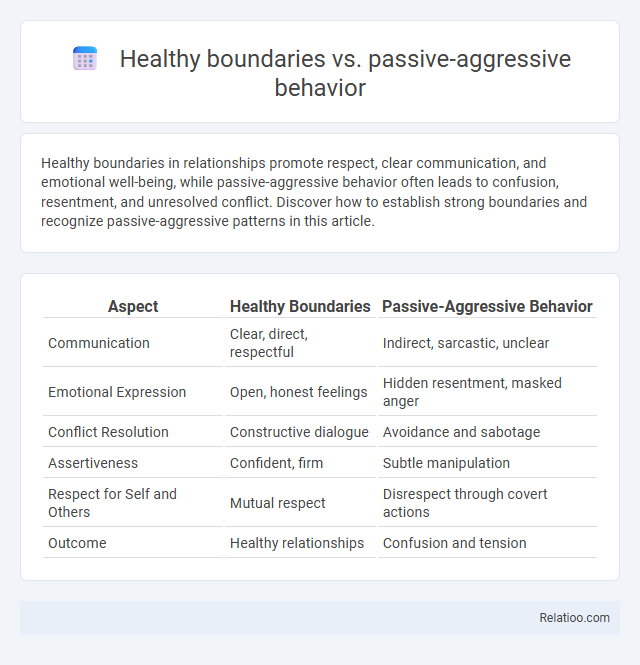Healthy boundaries in relationships promote respect, clear communication, and emotional well-being, while passive-aggressive behavior often leads to confusion, resentment, and unresolved conflict. Discover how to establish strong boundaries and recognize passive-aggressive patterns in this article.
Table of Comparison
| Aspect | Healthy Boundaries | Passive-Aggressive Behavior |
|---|---|---|
| Communication | Clear, direct, respectful | Indirect, sarcastic, unclear |
| Emotional Expression | Open, honest feelings | Hidden resentment, masked anger |
| Conflict Resolution | Constructive dialogue | Avoidance and sabotage |
| Assertiveness | Confident, firm | Subtle manipulation |
| Respect for Self and Others | Mutual respect | Disrespect through covert actions |
| Outcome | Healthy relationships | Confusion and tension |
Understanding Healthy Boundaries
Healthy boundaries establish clear limits that protect personal well-being and foster respectful interactions, promoting emotional balance and self-respect. Passive-aggressive behavior, in contrast, involves indirect expressions of hostility or resentment, undermining open communication and damaging relationships. Understanding healthy boundaries helps distinguish respectful assertiveness from passive-aggression, enabling individuals to communicate needs effectively without resorting to covert hostility.
Defining Passive-Aggressive Behavior
Passive-aggressive behavior is a pattern of indirectly expressing negative feelings instead of openly addressing them, often through subtle actions like procrastination, sarcasm, or stubbornness. Unlike healthy boundaries, which involve clear and respectful communication about personal limits, passive-aggression undermines relationships by fostering confusion and resentment. Understanding this behavior is crucial for recognizing and addressing hidden forms of hostility in interpersonal dynamics.
Key Differences Between Boundaries and Passive-Aggression
Healthy boundaries involve clear, assertive communication that respects personal limits and promotes mutual understanding, while passive-aggressive behavior masks true feelings through indirect actions or subtle resistance. Passive-aggression often undermines relationships by expressing hostility covertly, whereas boundaries protect emotional well-being by openly defining acceptable treatment. The key difference lies in intention and clarity: boundaries establish respect and honesty, whereas passive-aggression fosters confusion and unresolved conflict.
Signs of Healthy Boundary Setting
Signs of healthy boundary setting include clear communication of personal limits, consistent enforcement of those boundaries, and respect for one's own needs and feelings without guilt. Healthy boundaries foster mutual respect in relationships, enabling individuals to express themselves honestly while maintaining emotional safety. Unlike passive-aggressive behavior or passive-aggression--which involve indirect expression of anger or resentment--healthy boundaries are direct, assertive, and promote psychological well-being.
Identifying Passive-Aggressive Responses
Healthy boundaries involve clear, respectful communication that protects personal well-being without causing harm. Passive-aggressive behavior manifests through indirect resistance and covert hostility, often disguised as compliance or silence. Identifying passive-aggressive responses requires recognizing patterns such as intentional procrastination, sarcasm, subtle undermining, and ambiguous communication that mask true feelings.
Impact on Relationships: Healthy vs. Unhealthy Dynamics
Healthy boundaries foster respect and clear communication, enhancing trust and mutual understanding in relationships. Passive-aggressive behavior and passive-aggression create confusion, resentment, and emotional distance, undermining connection and collaboration. Your ability to set and maintain healthy boundaries directly influences the strength and positivity of your interpersonal dynamics.
Communication Strategies for Setting Boundaries
Effective communication strategies for setting healthy boundaries involve clear, direct expression of your needs and limits without hostility or avoidance. Passive-aggressive behavior often masks true feelings through indirect communication, which undermines boundary setting and leads to misunderstandings. Prioritizing assertiveness and honesty helps prevent passive-aggression, fostering respectful interactions and stronger personal relationships.
Common Triggers for Passive-Aggressive Behavior
Common triggers for passive-aggressive behavior include feelings of resentment, fear of confrontation, and unmet needs, which can cause individuals to express anger indirectly rather than openly. You may notice passive-aggression emerging when someone feels powerless or overwhelmed, often reacting through sarcasm, procrastination, or subtle sabotage instead of addressing issues directly. Recognizing these triggers helps differentiate healthy boundaries, which involve clear and respectful communication, from passive-aggressive behavior that undermines relationships and emotional well-being.
How to Respond to Passive-Aggressive Individuals
Healthy boundaries involve clear, respectful communication that protects one's emotional well-being, while passive-aggressive behavior manifests through indirect resistance, sarcasm, or subtle undermining. Responding to passive-aggressive individuals requires assertiveness, calmly addressing the behavior without escalating conflict, and setting firm limits to prevent manipulation. Recognizing patterns of passive-aggression and maintaining consistent boundaries helps foster transparent dialogue and reduces emotional stress.
Cultivating Assertiveness for Healthier Interactions
Healthy boundaries involve clearly communicating personal limits to protect one's emotional well-being, fostering mutual respect in relationships. Passive-aggressive behavior undermines these boundaries by expressing negative feelings indirectly, often through sarcasm or procrastination, which confuses and frustrates others. Cultivating assertiveness enables individuals to express needs openly and respectfully, reducing the likelihood of passive-aggression and promoting healthier, more transparent interactions.

Infographic: Healthy boundaries vs Passive-aggressive behavior
 relatioo.com
relatioo.com